Tiny Epic Defenders - A Solo Review
08 Nov 2022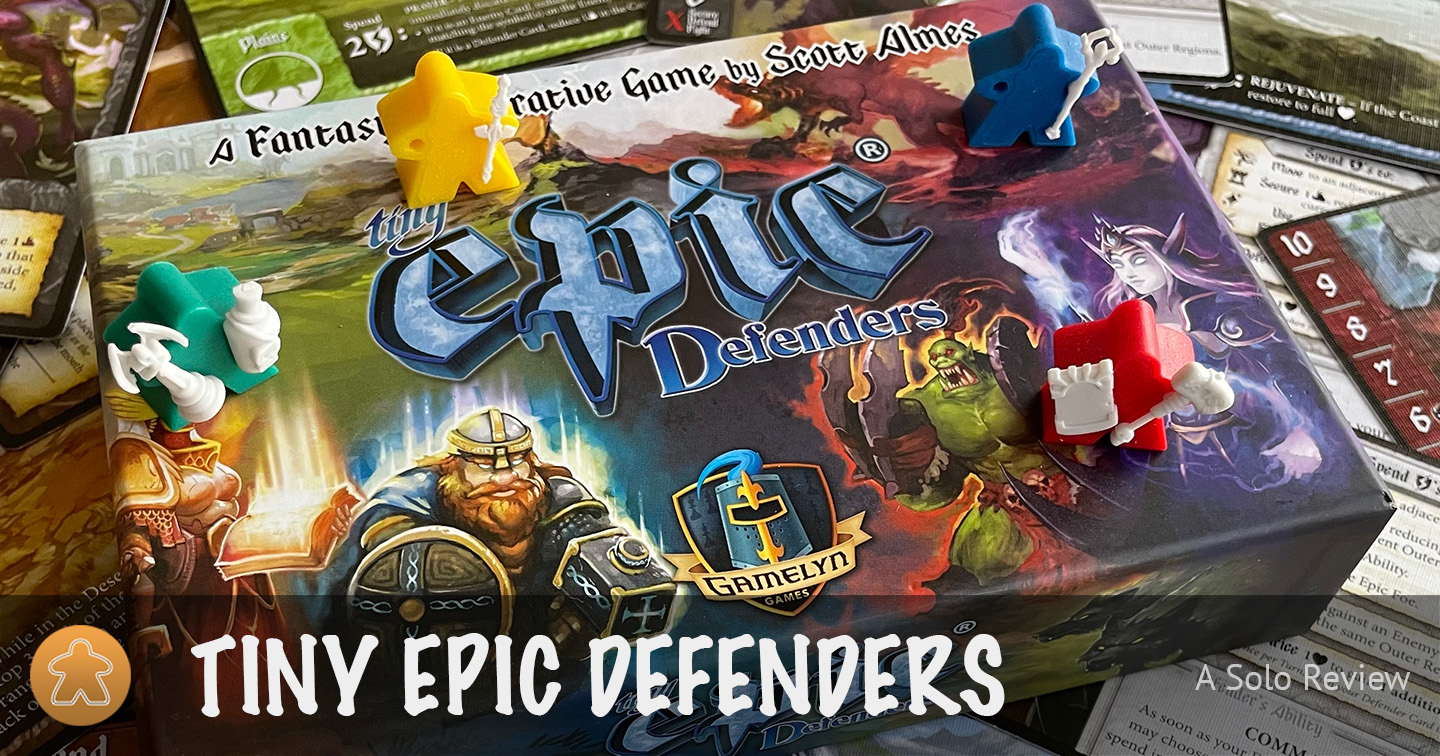
There’s never a dull moment in Aughmoore. You’ve barely returned from cleaning out a few dungeons and all the regions around the capital city are being attacked by harpies, giant wasps and dragons. Unfortunately there’s only two of you to defend the realm. Will you succeed?
Name: Tiny Epic Defenders, second edition
Designer: Scott Almes
Publisher: Gamelyn Games
Game type: hard to define actually… tower defense-like with action points?
What is Tiny Epic Defenders?
Tiny Epic Defenders is cooperative game for one to four players where you have to defend the different regions of Aughmoore from invading hostile creatures.
The world of Aughmoore is represented by seven cards: a central capital city and six regions around it. In a solo game you take control of two meeples. Every round you go through a growing deck of enemy cards, flipping them over one at a time. Certain cards in the enemy deck let you take actions with your meeples to keep the threat under control, but most cards contain two regions that get attacked. If one of your meeples is in such a region you can defend against the attack if you can and want to. If an attack against a destroyed region goes undefended, the hit gets transferred to the capital city. You lose when the capital city gets destroyed.
After five rounds an epic foe card gets revealed. Your only way to win is to reduce the boss’ health to zero before the capital city gets destroyed.
How does it play?
Before you start playing the game you have to do a tiny bit of setup:
- Lay out the regions. Take the seven region cards and place the six regular regions around the capital city card. Every region is double sided, with each side having a different region ability. Choose which side you want to use or pick them at random. Place two meeples on the capital city. Every region gets a threat token placed on the zero space.
- Create the turn deck. Take three random face down enemy cards and shuffle them. Take two defender cards corresponding to the color of meeples you want to use and two “all defender” cards and shuffle them. Place the shuffled enemy cards on top of the shuffled defender cards.
- Create the horde deck. Take three more random enemy cards, shuffle in two random dire enemy cards and place the five cards face down on top of a random face down epic foe card.
- Choose two characters to play as. Pick two of the 10 hero cards. Each hero comes with a certain maximum amount of health and a unique ability.
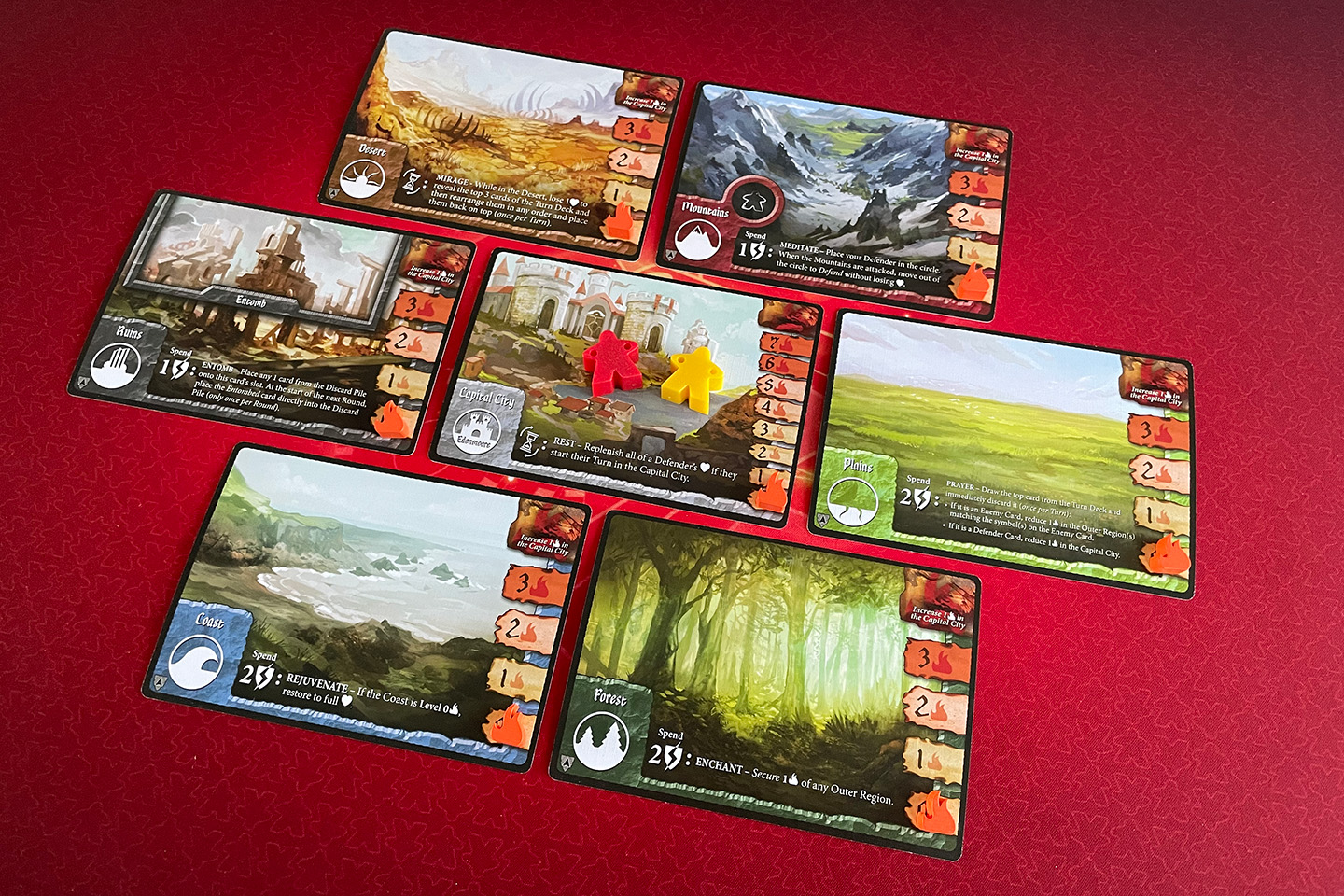
That’s it, you’re ready to play!
Flip over a card from the turn deck. There are three possible card types: enemy cards, defender cards and dire enemy cards.
- Enemy cards. These show two regions that get attacked. If a region does not contain one of your meeples, you move the region’s threat token one space up. If it ever reaches the fourth space, that region gets destroyed. You indicate this by placing the card that destroyed it face up on top of the region. If the region does contain one of your meeples, you can choose to defend against the attack. Sacrificing one health prevents the threat level from getting raised.
- Dire enemy cards. These show only one region, but they cost two health to defend against. They also contain a nasty effect that gets triggered if you don’t defend against their attack. If you do defend against the attack though, you get to draw an artifact card. These artifact cards are items that give the defending meeple an extra ability for the remainder of the game. In addition to the card, you can also take the corresponding physical item and attach it to your meeple. There are two places for items that are held in the hands and one space for items that are held on the back (e.g. a cloak), limiting the number and type of items your meeples can hold.
-
Defender cards. There’s one for each meeple and two “all defender” cards. The ones for specific meeples give those meeples three action points to use, or four if there is at least one destroyed region. The “all defender” cards give you three action points to use however you want with your two meeples.
There are a few things you can do with these action points: move to an adjacent region for one action point per card you move (the capital city is only adjacent to regions to its left and right), lower the threat of the region you’re in by one level per action point, or use the ability of your character, of the region you are in or of one of the artifacts you have equipped. You could for example lower the threat by one in your current region, move one region to the right and lower the threat by one there as well. Or you could move to the capital city. When you start your turn in the capital city, your health gets completely refilled. That’s very important, because when you’re out of health, you can only move; you can no longer defend, lower threat or use abilities.
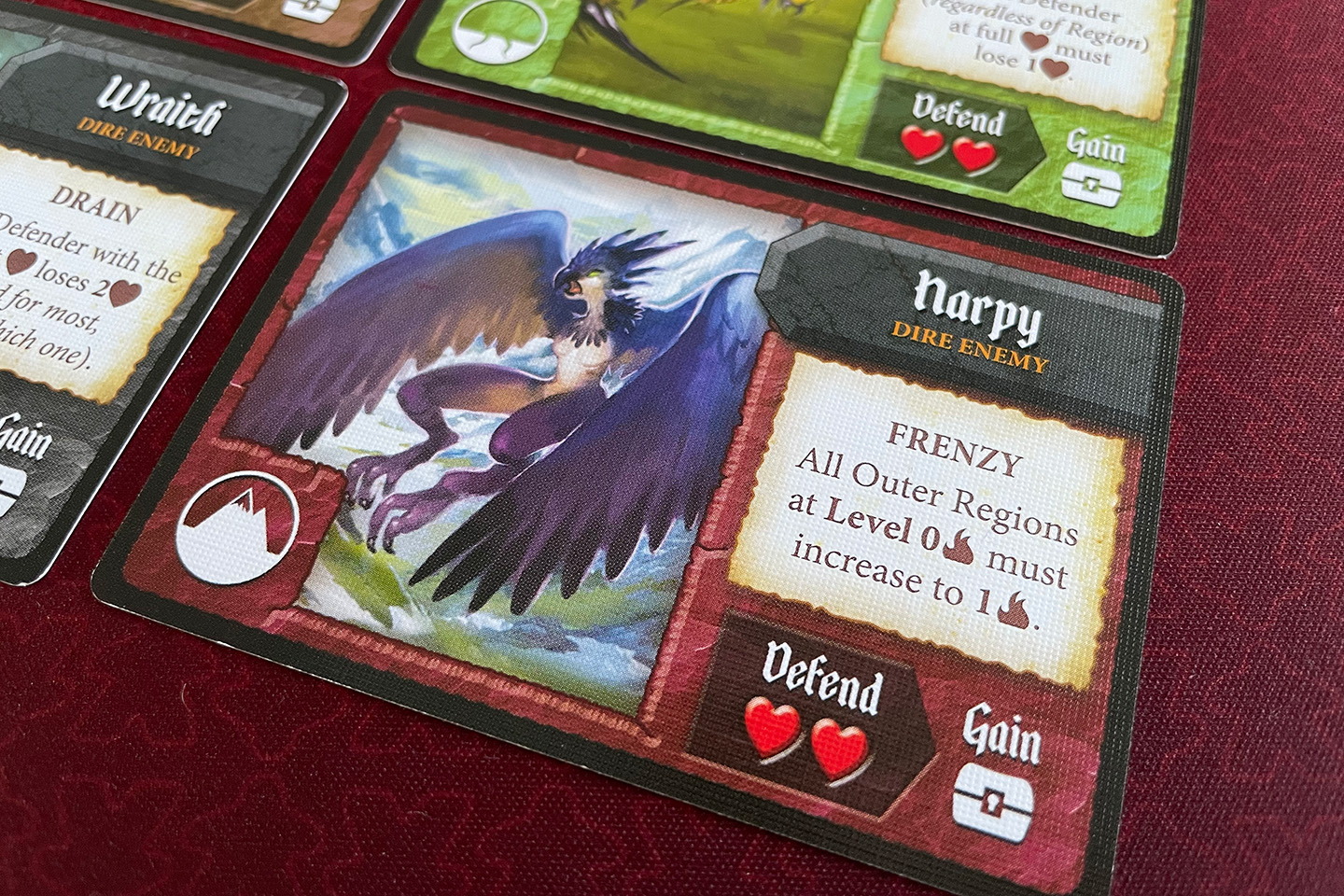
Once you’ve gone through the entire turn deck, you add the top card of the horde deck (no looking!) to the turn deck, shuffle it, and start again. This means the turn deck gets bigger and bigger, but you have an idea which cards are in there, just not in which order they will get revealed.
If the horde deck is empty when you would need to add a new card to the turn deck, you instead reveal the epic foe card. The epic foe does not get added to the turn deck, but it gets assigned to a specific region. Once the epic foe is revealed, one of the abilities your meeples can use is fighting the epic foe, provided they are in the correct region. For one action point you can do one damage to the epic foe. If you can bring the epic foe’s health to zero, you win the game. This sounds easier than it is, because each epic foe has its own unique effect and extra effects that can trigger when its health tracker reaches certain spaces. Additionally, while you’re fighting the epic foe, the other (dire) enemies just keep attacking the regions.
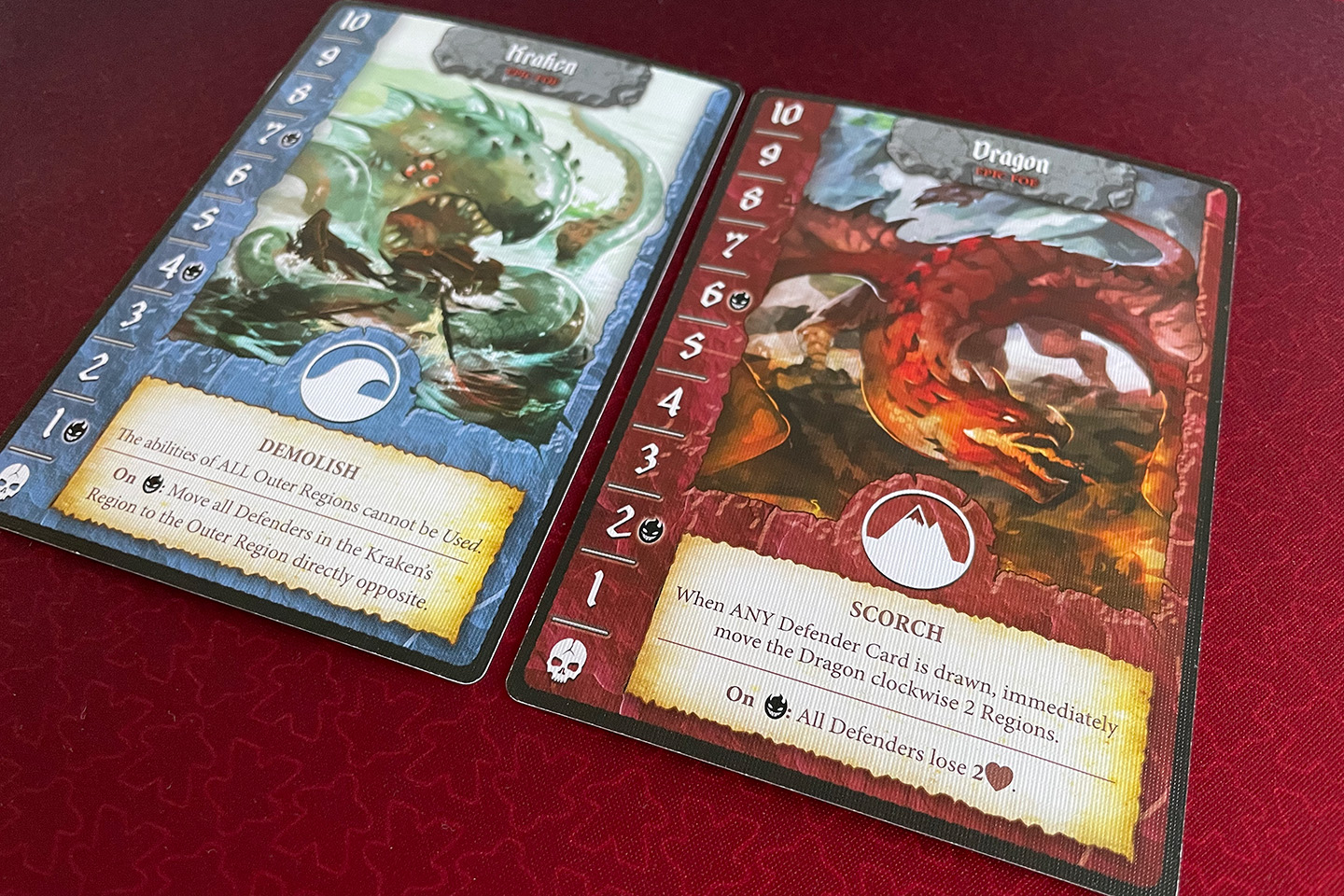
I’ve already mentioned regions get destroyed when their threat reaches level four. That’s bad for two reasons: you can no longer use the abilities of destroyed regions, and undefended attacks get transferred to the capital city, and you can’t defend the capital city or lower its threat level. If the threat in the capital city reaches level eight you lose the game.
What does it look and feel like?
The component quality is in line with the other Tiny Epic games, so if you’ve played one of them, you know what you can expect.
The cards feel sturdy and have a linen finish. I’ve shuffled the enemy cards a lot now and there’s no real visible wear or tear. I have no intention of sleeving them. The artwork on the cards is OK, but nothing special. When drawing an enemy card I never looked at the art, I just took note of the region symbol and moved on. So to me, the art doesn’t stand out, not in a bad way but also not in a good way. It’s just OK.
The special ITEMeeples® that can hold items in their “hands” and on their back are a bit of a gimmick. Cool at first, but after a handful of games I didn’t bother anymore with trying to attach the super tiny items to the meeples. Just having the artifact cards in front of me was enough.
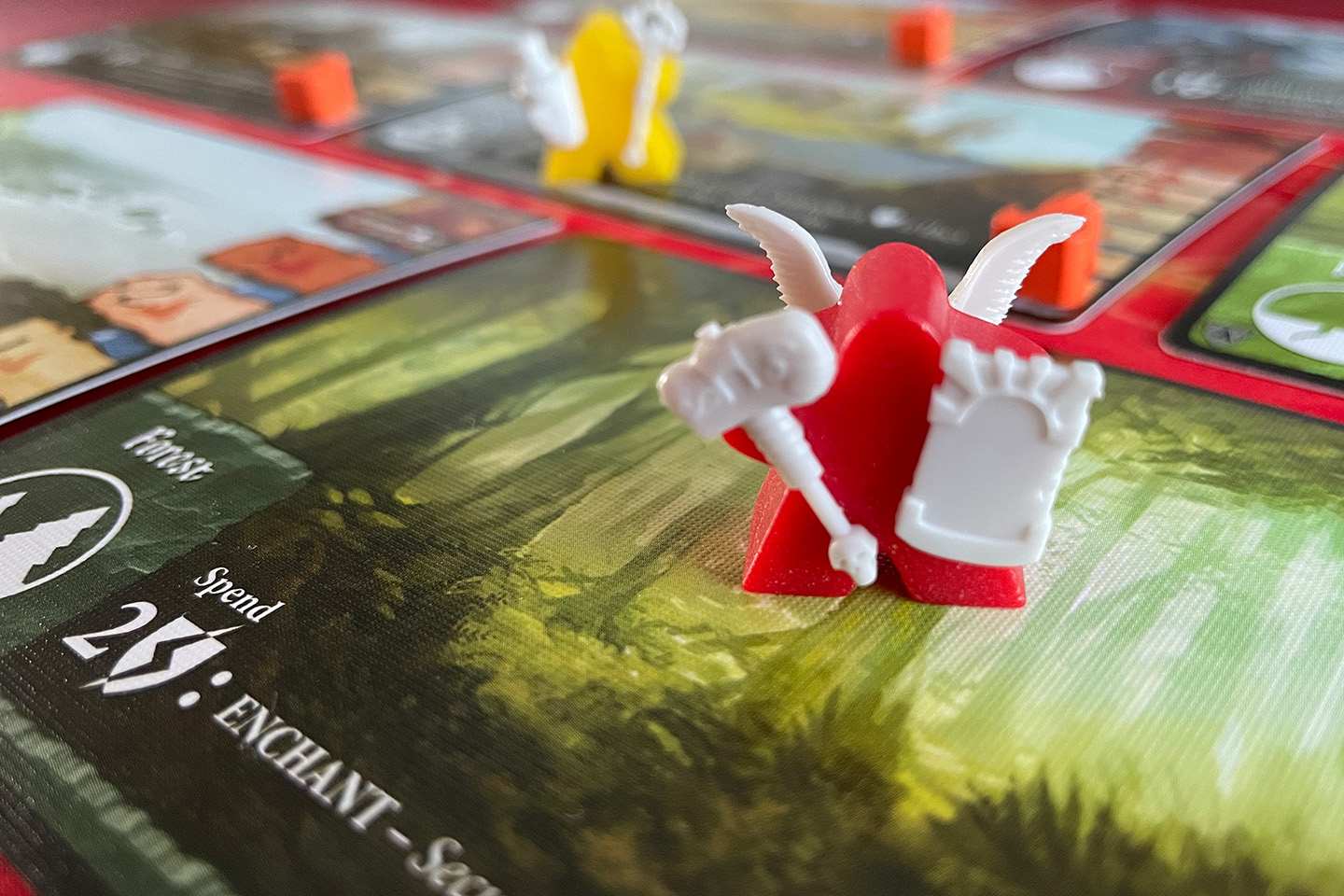
How much time does it take?
Setting the game up is fairly quick; I would less than five minutes. The same goes for packing everything up again.
I think a typical games takes me a round 20 minutes. Sometimes less, sometimes more, depending on how quickly the capital city gets destroyed.
All in all, including setup and teardown, 30 minutes is definitely realistic.
What is my verdict?
Before Gamelyn Games sent me this game for a solo review, I had already played it many times in multiplayer a few years ago. One of my friends has a copy and for a while it was our go to lunch time game at the office. I have to say I like this game a lot more when playing with four players than when playing it alone. Part of that comes from the player interaction you get when playing with others, part of that comes from the way the solo mode is a lot more difficult and random.
This is a cooperative game, so the player interaction isn’t competitive, but I really enjoy the back and forth discussions with other people. “The enemy card that attacks the forest and the mountains still has to show up and the dire enemy that attacks the coast as well… Maybe you should move to the mountains, securing the forest along the way. With a bit of luck Niels gets his turn before the dire enemy shows up so he can go to the coast and defend against the dire enemy to get an artifact?” This kind of discussion, trying to come up with good strategies to deal with what is still going to happen, is something I really miss when playing solo.
Something else that feels very different when playing with four players is that there are four meeples to handle everything. Sure, there are also more enemies to take care of, but that’s not the issue. Not counting the capital city, there are six regions. If you have four meeples spread out over the regions, you have covered 66% of them, meaning you will have a 66% chance to defend against the next card. When playing solo you only have two meeples, which means you only have a 33% chance —half as much— to defend against the next card. You’re spread out a lot thinner and that makes things a lot more difficult. The game tries compensate this by giving you two “all defender” cards, and while that certainly helps, it does not feel like it is enough. Now, it could very well be that this would not have been an issue for me if I had never played it in multiplayer. Maybe I would have just accepted it for what it was. But I can’t help comparing it to my experiences with four players, and I just find it less fun solo.
What I do like is the planning puzzle the game brings to the table. Trying to remember which regions get attacked, which have already showed up and which are still in the turn deck and coming up with a way to use actions points and character and region abilities to deal with those things can be really challenging and fun.
Unfortunately the randomness, especially the order in which the cards show up, can sometimes have a negative effect on that fun. I’ve lost games just because all defender cards happened to be at the bottom of the turn deck. Likewise, I’ve also won games just because the first two cards happened to be defender cards, allowing me to kill the epic foe; any other card would have destroyed the capital city. (This can also happen in the multiplayer game, but it is less punishing because you are covering more regions.)
Another thing I like is that there is some variability in the game. The relative position of the regions and which side is face up can change things up. Some region abilities affect the neighboring regions and sometimes the abilities of those neighboring regions work nicely together. The variety in heroes, epic foes and dire enemies also helps to keep things interesting.


All in all it’s not a bad game. If you like trying to plan things out and solving puzzles and don’t mind a bit of randomness that causes swingyness, this might be a game you should check out.
Score
To make things easier for myself, I use the same scoring categories Board Game Geek uses.
Comments
I'm sorry, I don't support comments on my website. If you want to discuss the game or my review, feel free comment on this dedicated Instagram post or my review on BGG.